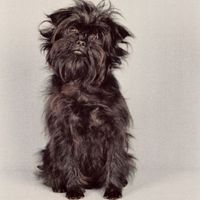
Appenzell Mountain Dog / Appenzeller Sennenhund, Appenzell Cattle Dog

Breed history:
This breed was obtained through the crossbreeding between local dogs with the Mastiff breeds brought to Switzerland by the Romans. Through these crossbreedings, four breeds were obtained. The Appenzell sheepdog is one of these breeds and was developed in the valleys of the Appenzell Canton, from where it gets its name.
Description:
It is a medium-sized, well-proportionated, brawny dog, with a square shape. The head is proportional to the body, with a straight and powerful muzzle. The eyes are small, almond-shaped, slightly slanting and dark hazel. The ears are placed high, medium-sized, triangular and drooping. The tail is placed rather high, of medium length, bushy and carried on the back in the shape of a ring. The fur has short, thick, rough, straight, glossy, close to the body hair. The main colour is black or brown with symmetrical white or rusty spots.
Personality:
It's a jolly, smart, very active, brave, confident, resistant dog that likes to bark. Faithfull and incorruptible defender of the family, it gets attached especially to one person. It gladly accepts children if it was well raised. Socialized from an early age with other dogs and animals, it doesn't have any problems with them. It is suspicious of and cautious with strangers.
Grooming:
This dog's fur doesn't require too much care. An occasional brushing and a more frequent one during the shedding period is enough.
Living conditions:
This dog is resistant to weather changes. It feels good in the open with an active master. It likes to make a lot of exercise that's why it is recommended to be kept in houses with a lot of space, such as farms. It feels connected to its territory and its family. It needs activity, training and socialization.
Training:
It is an easy to train dog because it is smart and likes to be kept busy. The training must be well-balanced and consistent. It likes to have an activity, it gladly participates in agility contests and flyball.
Usefulness:
In the past it was used to herd and guard cattle. Today it is used as a watchdog for houses or farms, as a search and rescue dog, searching for people caught in avalanches, or as a companion dog.


Austrian Shorthaired Pinscher
Austrian Pinscher, Osterreichischer Kurzhaarpinscher, Österreichischer, Österreichischer Pinscher




